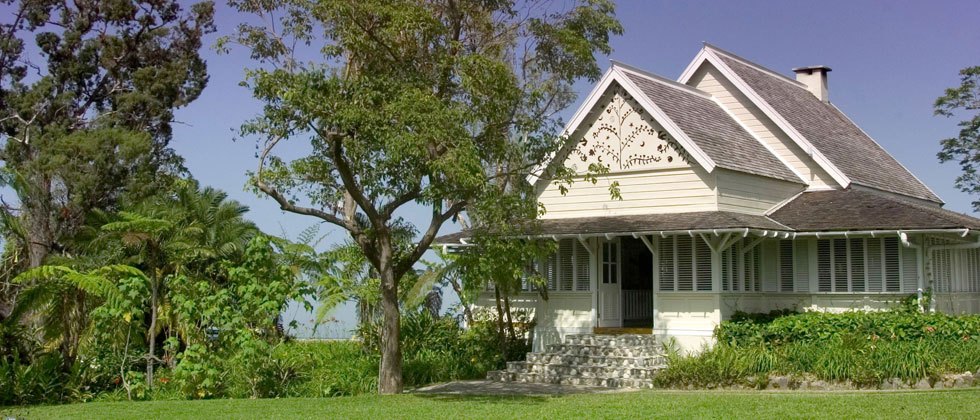The Farm
Climate
Strawberry Hill Jamaica Resort’s 48 acres are located within the 3,000ft altitude of the Port Royal Mountains, themselves part of the Blue Mountain range. 2,000mm of rainfall is recorded annually somewhat seasonally between March – May and October – December with temperatures between an absolute minima of 8.5C (December through to January) and an absolute maxima of 30C (July to August) with an average monthly temperature of 20C. The relative humidity is usually above 80% as a result of low cloud cover, and it is this combined with the wind and temperature that creates the unique microclimate allowing a very diverse range of plants to grow together.
 Aspects and Canopies
Aspects and Canopies
Strawberry Hill has slopes facing 3 main aspects, North, South West and South. The North slope is secondary forest with a mixed canopy of Clethra occidentalis, Podocarpus urbanii, Cecropia peltata, Hedyosmum arborescens. However lower down the slopes Dendropanax spp, Eugenia spp, Cleyera spp, Solanum spp, Turpinia spp and Ilea spp are found, but more prevalent on the Western slopes. The upper western slopes have been cultivated since the 19th century in Coffee resulting in a canopy of Mangifera indica (blackie mangoe), Cedrela odoratissima (cedar), Hibiscus elator (Blue Mahoe), Pinus caribea (Caribbean pine) and Bambusa vulgaris (bamboo)- a sure sign of cultivation. The upper southern slopes are exposed to the prevailing winds and as a result have a complete cover of Panicum vulgaris (guines grass). However the lower and leaward slopes show signs of vegetation more associated with dry limestone forest with Aloe spp, coccoloba spp, Clethra spp and Syzgium spp predominating.
Landscape History
The property was one of Jamaica’s first coffee plantations using the seedlings brought in by Sir Nicolas Lawes and the presence of Dutchman’s pipes excavated during the construction of the hotel attest to this period circa 1728. Reputedly deeded to Sir Horace Walpole, 4th Earl of Orford and named after his estate in England, the property still retains the original layout and some plant material.
The lower water tank on the main Irish Town road is sited on the old stables and the old driveway winds below the Spa lined with Juniperus barbadeae a standard road accent plant used at that time. An enormous rust bourganvillea located in the Spa gardens, is thought to be an original Mediterranean species imported circa 1890. At the same time the Cedrela, ( a wood used in furniture manufacturing) located outside the Library Terrace, is known to have been planted in 1890 by Dr Grace to replace its parent that was felled and used to panel the old Great House. Other additions at this time are the Eucalyptus nicolae located next to the pool, Podocarpus spp on the Ropley point and Cycas revoluta encompassing the Sago circle.
 Coffee Cultivation
Coffee Cultivation
Coffee was introduced to Jamaica in 1728 by Sir Nicolas Lawes, first from Martinique and then Coast Rica. The coffee grown here is Caffea Arabica var: Caturra and some numbered hybrids that produce that produce shorter bushes, more intense knitting (up to 23 beans per node) and earlier production. We intend to grow our coffee respectful of the contours of the land to check erosion, and to use the existing tree canopy of Musa, Mangifera and Cedrela, supplemented with Neem, as shade cover.
The bushes flower from January to April/ May with our reaping done in August. Our altitude of 3,000ft qualifies our coffee as Blue Mountain with a ripening time of 3 months.
The husbandry of coffee is intense with pruning, selection of strong leaders, the removal of gormandizers and encouragement of lateral growth being the key elements to achieving the magical yield of 100 boxes per acre. It is of interest to note that from 10Kg of wet cherry, only 4kg of dried green bean is extracted. The major pests are Berry Borer, leaf minor and scale insect and sometimes, associated moulds as result of close knitting and dense shade.
It is a difficult and labour intensive crop, however we all drink the fabled Blue Mountain coffee – the true meaning of which is derived from the Arabic word “Kawah” meaning “strength”.



